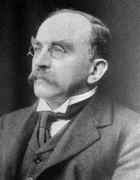Person: Larmor, Sir Joseph

Joseph Larmor worked on electricity, dynamics and thermodynamics.
Mathematical Profile (Excerpt):
- Hugh Larmor was a farmer at the time Joseph was born but he gave up farming when Joseph was around six or seven years old to become a trader with a grocer's shop in Belfast.
- By the time Joseph was of an age to attend school, his parents had moved to Belfast so it was in that city that he attended the Royal Belfast Academical Institution.
- After leaving school, Larmor continued his education in Belfast, studying for his B.A. and M.A. at Queen's University, Belfast.
- It is interesting to note that J J Thomson, who like Larmor would make an important contribution to the understanding of the electron, was Second Wrangler (taking second place in the Mathematical Tripos examinations to Larmor).
- After graduating Larmor was elected a Fellow of St John's College.
- Larmor's contributions came at a time when there were major revolutions in physics with the passing of classical physics to be replaced by quantum theory and relativity.
- The main underlying idea was the principle of least action, which would be of fundamental importance in all Larmor's work throughout his career, and its implications were first set out by him in his paper Least action as the fundamental formulation in dynamics and physics which he published in the Proceedings of the London Mathematical Society in 1884.
- During these three years (1894-97) the most basic principles of Maxwell's theory of electromagnetism were abandoned, and the entire subject was reconstructed on a new foundation - the electron - by Joseph Larmor in consultation with George FitzGerald.
- Larmor initially tackled the problem of the earth's motion through physical optics and thermodynamics, but ...
- In this specifically electromagnetic context, Larmor confronted the problem of the null result of the Michelson-Morley experiment, adopted the famous FitzGerald-Lorentz contraction hypothesis, and became the first physicist to employ what are now called the 'Lorentz' transformations.
- Larmor wrote Aether and Matter in 1900 (renamed by Lamb Aether and no matter ) which was a winning entry for the Adams Prize at Cambridge in 1898.
- Indeed, none of the recent scholarly studies of Larmor's scientific work even mention the now famous formulae and theorem.
- We should take Warwick's lead and make sure that we mention those concepts to which Larmor's name is attached today.
- These are the 'Larmor precession', the 'Larmor frequency', 'Larmor's theorem' and 'Larmor's formula'.
- The Larmor frequency relates to electrons orbiting in a magnetic field and led him to postulate electrons as orbiting around some centre.
- Larmor's theorem is a related result concerning how a certain transformation can negate the magnetic field for a charged particle subject to electric and magnetic fields.
- He was the first to calculate the rate of energy radiation from an accelerating electron and for this he gave Larmor's formula which gives the power radiated in terms of the electron's charge and acceleration.
- However, Larmor certainly did not rush to embrace the new ideas of space time which were being developed.
- When George Stokes and William Thomson (Lord Kelvin) died, Larmor acted as an editor for their complete works.
- Larmor also put considerable effort into writing obituaries of Stokes (1903), Gibbs (1905), and Thomson (1908).
- Larmor retired from the Lucasian Chair of Mathematics at Cambridge in 1932.
- With his health deteriorating, Larmor returned to Ireland where he spent his final years at Holywood, County Down.
- The Royal Society elected Larmor as a Fellow 1892 and he served as secretary from 1901 to 1912.
- Knighted in 1909, Larmor served as MP for the University of Cambridge from 1911 to 1922.
- Larmor was active in college affairs, being a member of the council of St John's College for many years.
Born 11 July 1857, Magheragall, County Antrim, Ireland. Died 19 May 1942, Holywood, County Down, Ireland.
View full biography at MacTutor
Tags relevant for this person:
Applied Maths, Origin Ireland, Physics
Thank you to the contributors under CC BY-SA 4.0! 

- Github:
-

- non-Github:
- @J-J-O'Connor
- @E-F-Robertson
References
Adapted from other CC BY-SA 4.0 Sources:
- O’Connor, John J; Robertson, Edmund F: MacTutor History of Mathematics Archive
